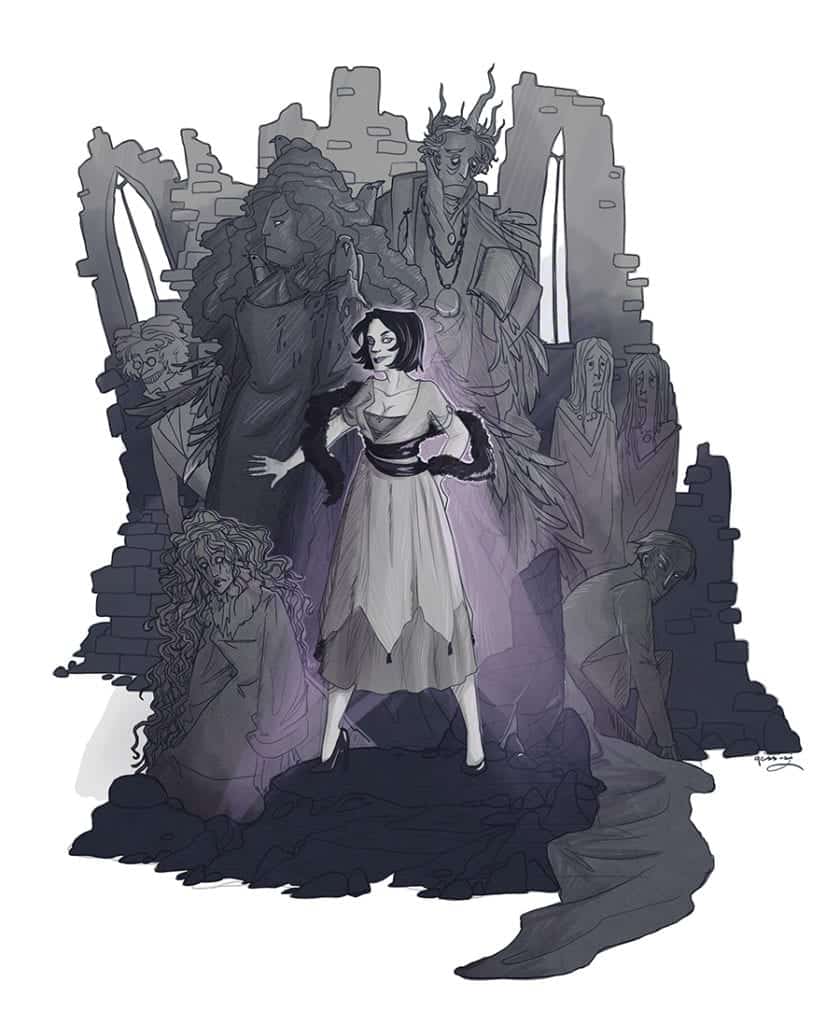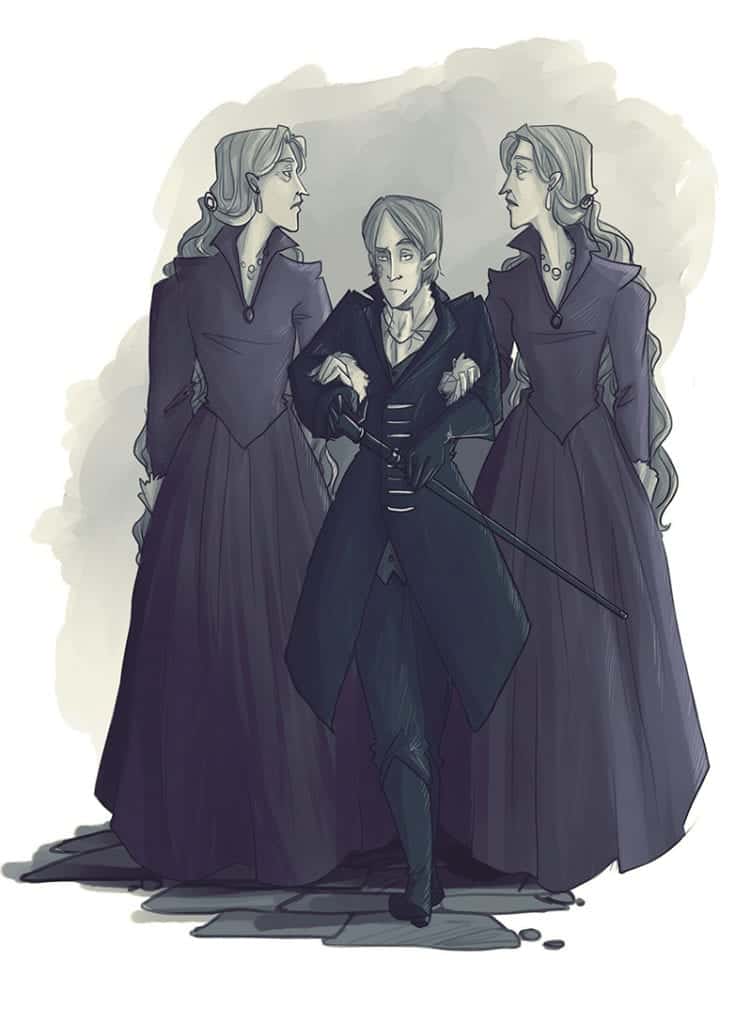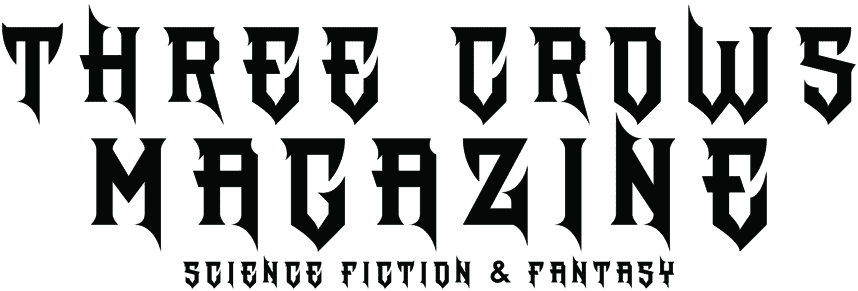Intruders in Gormenghast
Gormenghast made Mervyn Peake famous, but writing might be the least interesting aspect of his life. As a young child, he fell in love with Treasure Island while living in China. Later, his family moved to England where he became a successful painter and illustrator. Among other works, he illustrated Carroll’s Alice’s Adventures in Wonderland and, of course, Dickens’ Bleak House, where he could express his love for the bizarre and gothic. Peake’s talent could not just be found in books, he was also commissioned to depict heart-breaking war scenes for various newspapers during WWII.

He began working on the Gormenghast novels while in the army. In 1946 Titus Groan was published, followed by Gormenghast in 1950 and finally Titus Alone in 1959. He planned to write more but alas, an illness struck him down, gradually stripping him off his artistic abilities. Twisting his mind with visual hallucinations and paranoid delusions, it rendered his words incoherent and his illustrations crude and nightmarish. Back then, it left doctors baffled, today we know he was afflicted by dementia with Lewy bodies, a neurodegenerative illness, dismantling a brilliant mind while still far too young. [1]
We enter the world of Gormenghast as unwelcome intruders in Titus Groan. It opens with a series of chapters introducing the titular crumbling castle, Gormenghast, and its many residents. Each character has their own chapter and while discovering a place filled with people who follow complex, ancient rituals, unwilling to modernise or evolve, the reader is dunked into an atmosphere of gothic novels resembling Radcliffe’s The Mysteries of Udolpho, where the setting becomes more important than the plot.
In fact, the Gormenghast trilogy doesn’t offer much in terms of plot and could probably be summarised in a single paragraph. What will remain with the reader after almost a thousand pages is the prose, the chilling atmosphere, the exceptionally detailed descriptions of the castle, the rituals, and the characters, which results in an immersive, lasting experience.
At the beginning of the first book, Titus, the heir of Gormenghast, is born, while at the same time Steerpike, a seventeen-year-old boy, escapes the castle’s kitchens where he’d spent his childhood.

Titus grows up to rebel against tradition, harbouring a strong desire to become independent, flee what he considers a prison and see the world. The idea of being trapped by tradition for the rest of his life renders him miserable. He sees Gormenghast as confinement: murky and falling apart, – just like its bizarre inhabitants. Titus never evolves into anything more than the rebellious heir who rejects his place in society. His name may be in the title of the books, but for the most part of this epic work, he is simply a boy—a passive participant in many rituals, like his own baptism.
On the other hand, there’s Steerpike. He wants to rise to the top, escape the life of a kitchen boy and does not shy away from murder to achieve his goal. He speaks of a socialist revolution, equality, and the toppling of the aristocracy, but by utilizing arson and murder with not a hint of remorse to meet his ends, he becomes so malicious, he rivals both Professor Umbridge and Steinbeck’s Cathy Ames. “If ever he had harboured a conscience in his tough narrow breast he had by now dug out and flung away the awkward thing – flung it so far away that were he ever to need it again he could never find it.”

Besides the accurate depiction of a socialist revolution attempted by a greedy man, Peake explores themes including tradition, rituals, social duty, and—through Titus—the search and right for self-definition, instead of being defined by society and birth.
“If anything, he [Peake] should be compared to the New Weird rather than Tolkien and epic fantasy.”
Gormenghast’s main strength is its social commentary. Peake presents character studies much like other English writers (Austen, Dickens) did. Titus’ aunts who are longing for power long lost are as hysterical as Mrs. Bennett or Mr. Collins. Just like in Austen’s books there is a lot of humour in the prose used to subtly poke fun at a society determined to hold onto old traditions. No matter how ridiculous the Gormenghast rituals seem to the reader, nor how serious the characters feel about them; no matter how malevolent Steerpike’s actions appear, it’s all coated with a generous dollop of British humour. There isn’t one quote to easily display the humour. Most of it is too subtle, buried in context, like the twins who squabble, mirroring each other; the unwed Irma who makes a bust out of a hot water bottle to attract a respectable suitor; or the old Earl who is eaten by owls.
This book is best read slowly (not difficult, since it’s not exactly a page-turner) because almost every paragraph has a passage that will make the reader chuckle. Recently, Susanna Clarke did something similar with Jonathan Strange & Mr Norrell, only her work wasn’t half as surreal as Peake’s despite introducing magicians to England’s history.
At its heart, it’s a fantasy of manners, but Peake’s work is just as bizarre as Miéville’s. If anything, he should be compared to the New Weird rather than Tolkien and epic fantasy. Reading the Gormenghast books highlights that writers can push boundaries and even openly defy them. Even better, a writer can do anything they like—no idea is too outlandish if executed in a compelling way. Capturing the reader’s attention is what matters. Peake does this by creating a cast of incredibly weird, grotesque characters inhabiting a place that couldn’t possibly exist.

But how can such work ever be successfully adapted? British television often has a touch of the absurd and a very distinct humour. Fawlty Towers, Red Dwarf, or—to take a more recent example—modern Doctor Who are all different compared to American TV, which often focuses on more obvious in-your-face kind of humour like The Big Bang Theory. Of course, British television isn’t bereft of slapstick and American-style sitcoms, but often the humour is wry and subtle.
The 2000 BBC adaptation of Gormenghast is no exception. Almost theatrical, it felt overwrought, reminiscent of pantomime. Just like the books, this adaptation would struggle to appeal to a modern audience only twenty years after its release. It was, however, a faithful adaptation. The characters in the book are a caricature, with a select few qualities drawn out to the extreme. Any attempt to tone that down would result in a betrayal of the original work.
Currently, Neil Gaiman is working on a new television adaptation. It’s unclear if he’ll adapt all three novels or stick to the first two like the BBC series did. Gaiman’s imagination has proven to be vast, at times surreal, and perhaps it needs a mind like his to do justice to the Gormenghast novels. With his popularity, Gaiman will drag Peake’s work from the shadows and expose it to a wide audience. An audience who is prepared to listen to Gaiman’s wonderful stories, and hopefully will give his version of Gormenghast a chance.
Is Gormenghast worth reading? The answer is yes, but without magic, dragons, elves or sword fights, Peake’s work may not appeal to the traditional fantasy fan who expects the aforementioned elements, and literary readers may be put off by the bizarre characterisation and the grotesqueness of the piece and stop reading—even though persistence would reveal wonderful prose and fascinating character studies. If Austen’s social commentary remains relevant to this day, so should Peake’s.
In the end, Gormenghast leaves the modern reader flabbergasted, perhaps wondering what the point of it all is, but they’ll never forget Steerpike’s inherent malice, the gothic atmosphere surrounding them while exploring the castle, and the many times Peake’s descriptions made them chuckle. •
[1] Dementia With Lewy Bodies and the Neurobehavioral Decline of Mervyn Peake by Demetrios J. Sahlas, MD, MSc
About the Author
Olivia Hofer is a gay writer and editor of Three Crows Magazine. She is originally from Switzerland, currently living in England with her partner.




